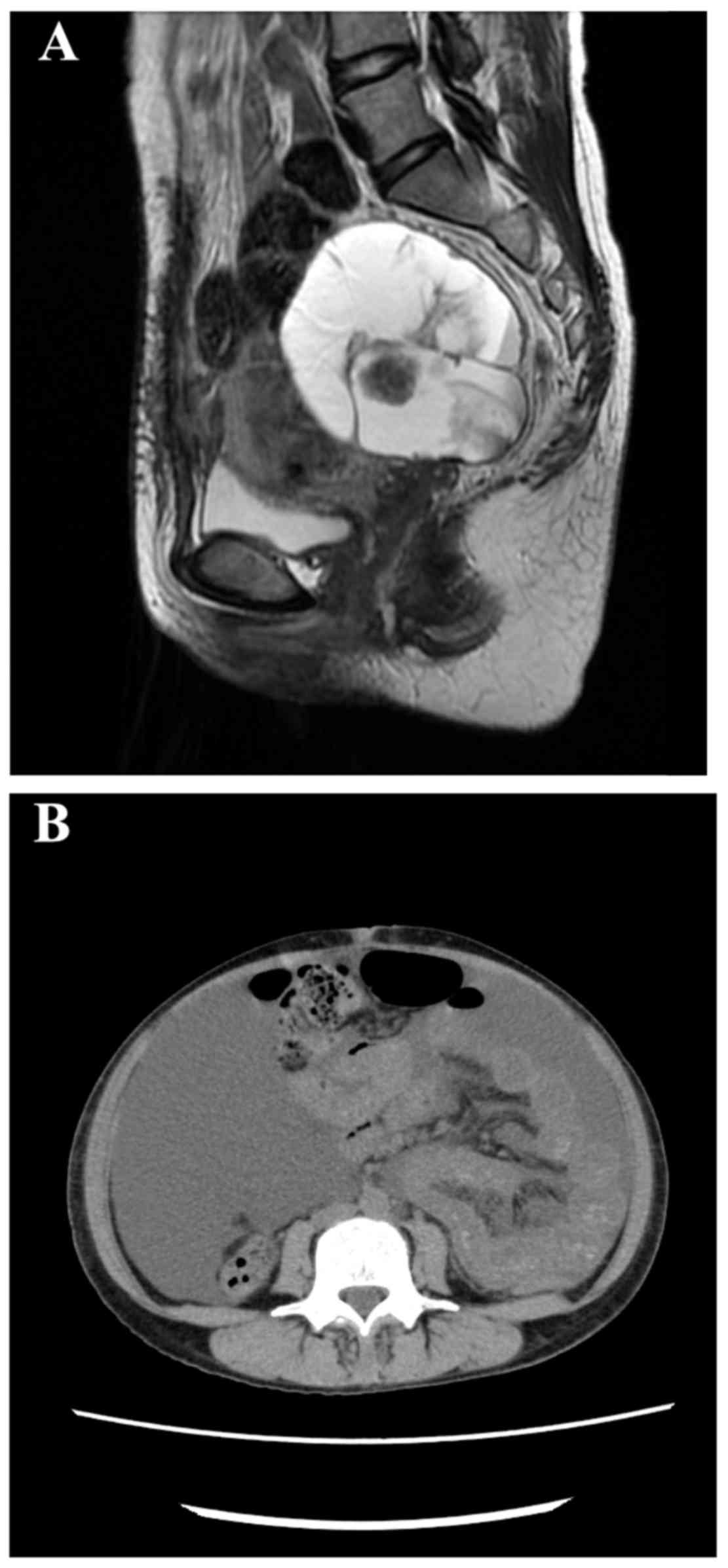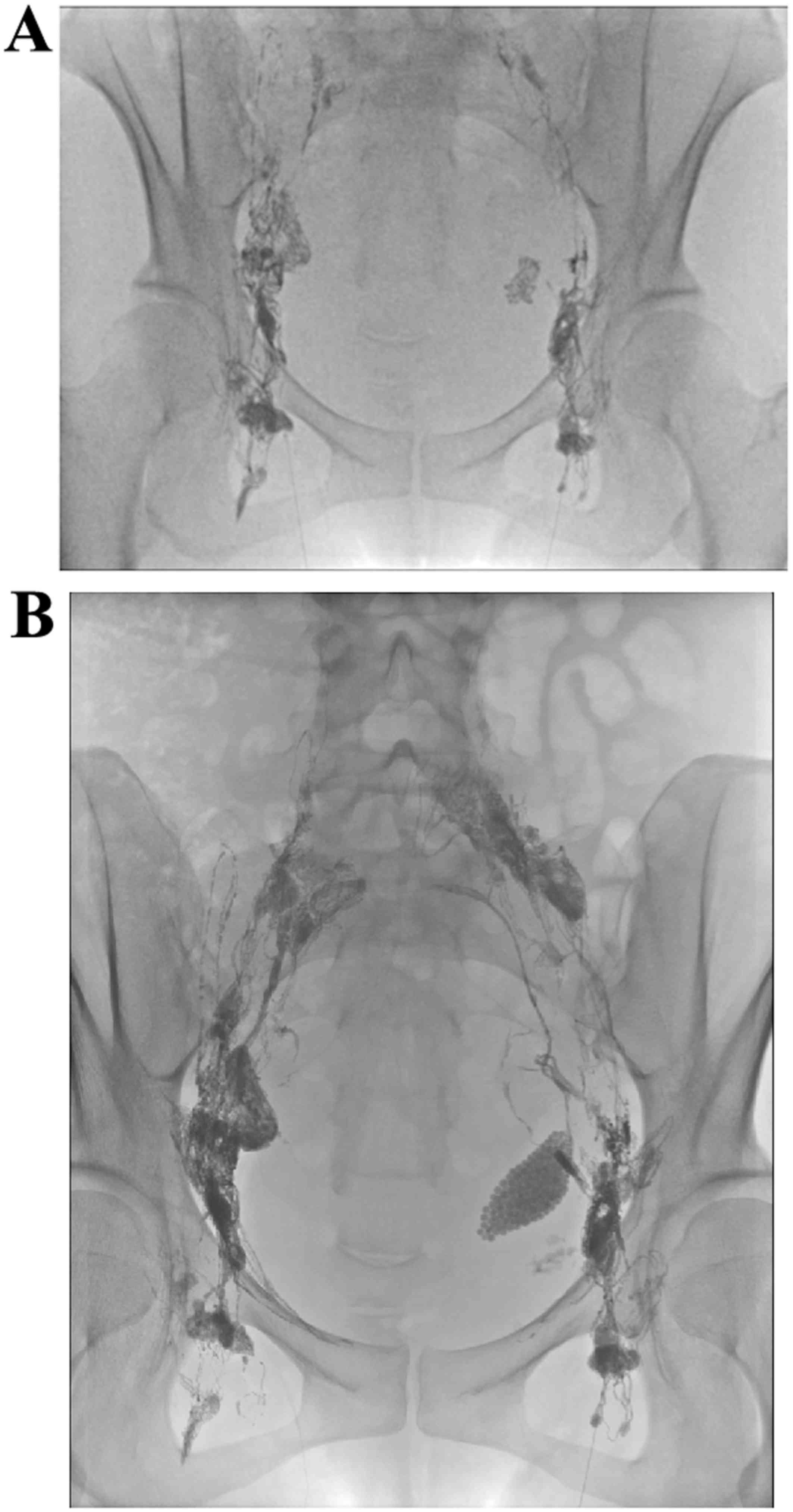Ultrasound-guided intranodal lymphangiography with lipiodol for treatment of chylous ascites following surgery for ovarian cancer: A case report
- Authors:
- Published online on: June 8, 2018 https://doi.org/10.3892/mco.2018.1647
- Pages: 178-180
-
Copyright: © Nakamura et al. This is an open access article distributed under the terms of Creative Commons Attribution License.
Abstract
Introduction
Chylous ascites is the build-up of lymphatic fluid in the peritoneal cavity. Chylous ascites occurring following surgery is uncommon, but may result from injury to lymphatic vessels during retroperitoneal surgery. Treatment mainly includes conservative measures aimed at decreasing chyle formation. Treatment methods may involve introducing a low-fat diet with medium-chain triglycerides, total parenteral nutrition, administration of octreotide and paracentesis. For patients who are refractory to these methods, lymphangiography is a proven beneficial diagnostic tool, and may also be used as a therapeutic intervention for lymphatic leakage to help avoid extensive surgery (1–3).
We herein describe the case of a patient with ovarian cancer who developed severe chylous ascites following pelvic and para-aortic lymph node dissection and was effectively managed by ultrasound-guided intranodal lymphangiography.
Case report
A 33-year-old pregnant woman (gravida 2, para 2) presented with a small left ovarian tumor that started to increase in size after delivery. The patient's medical and surgical history was unremarkable and the findings on general physical examination were normal. The hemoglobin level was 11.6 g/dl, the carbohydrate antigen 19–9 level was markedly elevated at 107.4 U/ml (normal, <37.0 U/ml), the cancer antigen 125 level was mildly elevated at 39.8 U/ml (normal, <35.0 U/ml), and the carcinoembryonic antigen level was within the normal range.
Pelvic magnetic resonance imaging (MRI) revealed a mass sized 57×84×84 mm3 with multilocular cysts, including small solid parts in the left adnexal region (Fig. 1A). MRI revealed no evidence of peritonitis carcinomatosa, ascites, dissemination nodules, or metastasis to the omentum. Contrast-enhanced computed tomography (CT) revealed no lymphadenopathy or distant metastasis.
As the intraoperative rapid diagnosis based on a right ovarian specimen was ovarian carcinoma, total abdominal hysterectomy, bilateral salpingo-oophorectomy, omentectomy, and pelvic and para-aortic lymphadenectomy were performed. Upon completion of the primary debulking surgery, no residual tumor was identified. The resected specimens were examined by a pathologist and the final diagnosis was seromucinous ovarian cancer (pT1c1N0M0, stage IC1).
On postoperative day (POD)3, milky appearance of the drainage fluid (800–1,000 ml/day) was continuously observed from the abdominal drainage tube. Although a fat-restricted diet was initiated, the volume of the discharge did not decrease. Following removal of the drainage tube, the patient developed increasing abdominal distention due to the large volume of chylous ascites. Thus, a daily subcutaneous injection of 100 µg octreotide was administered, in addition to total parental nutrition starting on POD21. However, the amount of chylous ascites gradually increased (Fig. 1B), and ascites drainage was required several times during treatment. As no improvement was observed on POD60, lipiodol lymphangiography was conducted on POD62 following a consultation with an in-house radiologist. Ultrasound-guided access to the inguinal lymph nodes bilaterally was achieved using a 27G needle, and lipiodol was slowly administered to the lymph nodes at ~6 ml/h under fluoroscopic guidance to ensure proper access (Fig. 2A). Following injection of ~12 ml of lipiodol, fluoroscopic imaging demonstrated accumulation of lipiodol at the left pelvis (Fig. 2B).
Following lymphangiography, the volume of discharge slowly decreased, and the abdominal distention gradually improved. On POD90 (28 days after lymphangiography) the patient resumed normal oral nutrition and on POD95 (33 days after lymphangiography) she was discharged from the hospital without recurrence of the ascites. The patient has remained asymptomatic and progression-free for 1 year.
Discussion
Postoperative chylous leakage is an uncommon but established complication that occurs following general surgery. Chylous ascites may occur due to conditions such as filariasis, tuberculosis, trauma, hepatic cirrhosis and complications associated with surgery. The reported incidence ranges from 1.3 to 3.4% following procedures involving the thorax and neck (4,5). Prophylactic ligation of the lymphatic duct is commonly conducted at the time of lymphadenectomy for gynecological cancer to prevent chylous leakage. Chylous leakage is potentially fatal due to the large amount of fluid, plasma protein, fat and immunoregulatory lymphocyte loss. Furthermore, affected patients exhibit clinical symptoms of severe malnutrition, hyponatremia, acidosis, hypocalcemia and susceptibility to infection. Therefore, uncontrolled chylous leakage is associated with a high mortality rate (3,6).
Initial treatment for chylous leakage generally comprises conservative methods, such as fasting, introducing a modified diet (low-fat with medium-chain triglycerides, parenteral nutrition and supplementation), drainage of the effusion, and administration of octreotide (7,8) and etilefrine (9). If conservative therapy is unsuccessful, surgical interventions, such as thoracic duct ligation, may be considered. However, it may not be easy to locate the thoracic duct or the site of chylous leakage at reoperation. Furthermore, surgical intervention is considered to increase the risk of complications, necessitating extreme care during the procedure.
Lipiodol lymphangiography has traditionally been used as a method for diagnosing chylous leakage and enables the identification of the leakage point for surgical intervention (3,10). However, lipiodol lymphangiography may also be applied as a treatment method. A previous study demonstrated that lipiodol lymphangiography was efficacious in 35% of patients with chylothorax, even when the volume of pleural drainage fluid was >500 ml/day. The procedure is also reportedly successful in 51% of patients who are refractory to non-surgical treatments (2). A study by Matsumoto et al (3) demonstrated that no surgical reintervention was required in 89% of patients with postoperative chylous leakage, and that chylous leakage may resolve following lipiodol lymphangiography in the remaining patients. Chylous leakage cessation following lipiodol lymphangiography is hypothesized to occur due to accumulation of lipiodol at the leakage point, which activates an inflammatory reaction and acts as an embolic agent (2).
The lymphangiography procedure traditionally includes subcutaneous injection of an oily contrast medium, such as lipiodol, into each foot. However, this procedure is associated with various problems. First, it is invasive, due to the need for dorsal incisions, thereby posing an infection risk. Second, it is technically difficult due to the need to isolate and cannulate the fine lymphatic vessels on the feet. Even following successful placement of the lymphangiogram needles, small movements by the patient may cause needle displacement. By contrast, intranodal lymphangiography using ultrasound has reduced the invasiveness of the procedure compared with the traditional method, as it does not require an incision. Instead, ultrasound-guided access to the inguinal nodes is achieved using a 23-26G spinal needle under local anesthesia, making intranodal lymphangiography a simpler and easier procedure.
Lipiodol lymphangiography was performed by gaining direct access to the bilateral inguinal lymph nodes using ultrasound guidance. This procedure was effective for treating this patient, who developed severe chylous leakage following surgery for ovarian cancer. This shows that lipiodol lymphangiography is an efficacious conservative treatment method for chylous leakage.
This single case report has obvious limitations. While lipiodol lymphangiography using bilateral inguinal lymph node puncture suggests the usefulness of thoracic duct embolization, additional prospective studies are required to determine the safety and efficacy of such methods.
Severe chylous leakage is uncommon, and the optimal management methods remain controversial. However, the outcome of the present case suggests that lipiodol lymphangiography is clinically effective for resolving chylous leakage following surgery for ovarian cancer.
Acknowledgements
Not applicable.
Funding
No funding was received.
Availability of data and materials
The datasets used and/or analyzed during the current study are available from the corresponding author on reasonable request.
Authors' contributions
KN has been involved in drafting the manuscript and participated in the experiment design and patient treatment. MI, TM, TI, KO, HY, RO, HS, SR and SKa carried out the treatment. KeN participated in the design of the study. SKy conceived of the study, and participated in its design and coordination and helped to draft the manuscript. All authors read and approved the final manuscript.
Ethics approval and consent to participate
The study protocol was approved by the Ethics Committee of Shimane University School of Medicine (Izumo, Japan; approval no. 960). The research was conducted in accordance with the Declaration of Helsinki and Title 45, US Code of Federal Regulations, Part 46, Protection of Human Subjects, effective December 13, 2001.
Consent for publication
The patient provided written informed consent for the publication of the case details and associated images.
Competing interests
The authors declare that they have no competing interests.
Glossary
Abbreviations
Abbreviations:
|
MRI |
magnetic resonance imaging |
|
CT |
computed tomography |
|
POD |
postoperative day |
References
|
Kos S, Haueisen H, Lachmund U and Roeren T: Lymphangiography: forgotten tool or rising star in the diagnosis and therapy of postoperative lymphatic vessel leakage. Cardiovasc Intervent Radiol. 30:968–973. 2007. View Article : Google Scholar : PubMed/NCBI | |
|
Alejandre-Lafont E, Krompiec C, Rau WS and Krombach GA: Effectiveness of therapeutic lymphography on lymphatic leakage. Acta Radiol. 52:305–311. 2011. View Article : Google Scholar : PubMed/NCBI | |
|
Matsumoto T, Yamagami T, Kato T, Hirota T, Yoshimatsu R, Masunami T and Nishimura T: The effectiveness of lymphangiography as a treatment method for various chyle leakages. Br J Radiol. 82:286–290. 2009. View Article : Google Scholar : PubMed/NCBI | |
|
Kaburagi T, Takeuchi H, Oyama T, Nakamura R, Takahashi T, Wada N, Saikawa Y, Kamiya S, Tanaka M, et al: Intraoperative fluorescence lymphography using indocyanine green in a patient with chylothorax after esophagectomy: report of a case. Surg Today. 43:206–210. 2013. View Article : Google Scholar : PubMed/NCBI | |
|
Paul S, Altorki NK, Port JL, Stiles BM and Lee PC: Surgical management of chylothorax. Thorac Cardiovasc Surg. 57:226–228. 2009. View Article : Google Scholar : PubMed/NCBI | |
|
Parvinian A, Mohan GC, Gaba RC, Saldanha DF, Knuttinen MG, Bui JT and Minocha J: Ultrasound-guided intranodal lymphangiography followed by thoracic duct embolization for treatment of postoperative bilateral chylothorax. Head Neck. 36:E21–E24. 2014. View Article : Google Scholar : PubMed/NCBI | |
|
Epaud R, Dubern B, Larroquet M, Tamalet A, Guillemot N, Maurage C, Clement A and Fauroux B: Therapeutic strategies for idiopathic chylothorax. J Pediatr Surg. 43:461–465. 2008. View Article : Google Scholar : PubMed/NCBI | |
|
Snow AL, Uller W, Kim HB and Alomari AI: Percutaneous embolization of a chylous leak from thoracic duct injury in a child. Cardiovasc Intervent Radiol. 37:1111–1113. 2014. View Article : Google Scholar : PubMed/NCBI | |
|
Ohkura Y, Ueno M, Iizuka T, Haruta S, Tanaka T and Udagawa H: New combined medical treatment with etilefrine and octreotide for chylothorax after esophagectomy: a case report and review of the literature. Medicine. 94:e22142015. View Article : Google Scholar : PubMed/NCBI | |
|
Ngan H, Fok M and Wong J: The role of lymphography in chylothorax following thoracic surgery. Br J Radiol. 61:1032–1036. 1988. View Article : Google Scholar : PubMed/NCBI |











